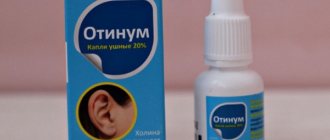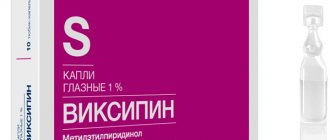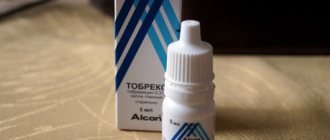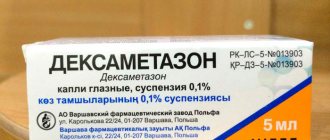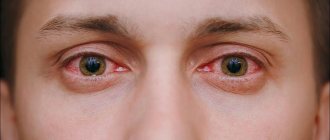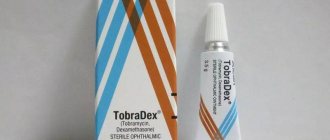Prohibited during pregnancy
Prohibited during breastfeeding
Has restrictions for children
Has restrictions for older people
Has limitations for liver problems
Has limitations for kidney problems
Sofradex is produced in drops for topical use with several active ingredients - dexamethasone, as well as neomycin and gramicidin. The drug is quite expensive, so many patients will benefit from information about cheap analogues of Sofradex.
Sofradex is prescribed for the treatment of bacterial pathologies of the eyes and ears, which are provoked by both bacterial and allergic agents. The drug is prescribed for the treatment of the following pathologies:
- blepharitis;
- conjunctivitis of allergic etiology;
- eczema on the eyelids due to the development of infection;
- barley;
- sclerites and episclerites;
- iritis and iridocyclitis;
- otitis in the acute phase of development and in the chronic phase.
Description of the drug
Sofradex is not used in ophthalmology for the following pathologies:
- viral infections in the eyes;
- herpes;
- fungal infections;
- glaucoma;
- pulmonary tuberculosis;
- allergies to components in the medicine.
In otorhinolaryngology, Sofradex is not prescribed if there is a hole in the eardrum. The use of the drug in the treatment of pregnant and lactating women is carried out as a last resort and only as prescribed by a doctor, because there are no clinical studies of the safety of Sofradex during this period.
Dosage
In the treatment of ophthalmic pathologies, it is necessary to drip 1-2 drops 4-6 times a day. The dosage and frequency of taking the medicine are prescribed by the attending physician based on the pathology and the degree of its progression. After reducing the acute symptoms of the disease, you need to reduce the dosage by half.
In the treatment of otorhinolaryngological pathologies, the medicine should be instilled into the external ear canal 3-4 times a day, 2-3 drops. The duration of therapy should not exceed 1 week.
Pharmacodynamics and pharmacokinetics
The drug Sofradex has a broad-spectrum bactericidal and antibacterial effect due to gramicidin and framycetin , and is active against such gram-positive and gram-negative microorganisms as:
- Staphylococcus epidermidis and aureus;
- Streptococcus pyogenes, pneumoniae and faecalis;
- Escherichia coli;
- Proteus spp.;
- Klebsiella spp.;
- Pseudomonas spp. and etc.
The glucocorticoid , dexamethasone, has an anti-inflammatory, antiallergic and antipruritic effect . As a result of instillation into the eye, pain, burning sensations are reduced, photophobia, lacrimation and other symptoms characteristic of pathological processes caused by the corresponding pathogens occur. In addition, it also appears to be effective for adenoids .
Pharmacokinetics
- Topical application leads to low systemic absorption.
- Framycetin sulfate is absorbed by inflamed skin or through open wounds. Entering the systemic circulation, it is rapidly excreted by the kidneys with an unchanged half-life of 2-3 hours.
- Dexamethasone is rapidly absorbed from the gastrointestinal tract, with a half-life of 3.16(6) hours.
Composition, release form
The drug Sofradex is produced in the form of drops, which are intended for use in ophthalmology and otolaryngology. Ear drops are packaged in a bottle made of dark glass.
In the original, the volume of the medicine is 5 ml. Also, each bottle is equipped with a dropper-pipette, thanks to which the instillation procedure becomes simpler and more convenient.
Sofradex drops contain the following active ingredients:
- framycetin sulfate;
- gramicidin;
- dexamethasone in the form of sodium metasulfobenzoate.
The first 2 components are powerful antibiotics with a wide spectrum of effects.
In addition to the main active ingredients, Sofradex drops also contain auxiliary components:
- sodium chloride;
- sodium salt of citric acid;
- phenylethyl and ethyl alcohol;
- twin 80;
- distilled water.
It is also worth noting that Sofradex is a medication that belongs to the group of antibiotics. This must be taken into account at the stage of choosing a treatment method for a particular disease.
Indications for use
Sofradex eye drops are usually prescribed for superficial bacterial eye infections with an inflammatory or allergic component, as well as for blepharitis , infected eyelid eczema , stye , allergic conjunctivitis , rosacea keratitis , scleritis , episcleritis , iridocyclitis , iritis .
Ear drops appear to be effective for acute or chronic otitis externa .
Overdose
According to the manufacturer, an overdose of Sofradex drops can occur if the drug is used for more than the period specified in the annotation - 7 days.
Overdose symptoms are caused by addiction to such an active ingredient as dexamethasone. In this case, an increase in all the adverse reactions described above is recorded, and disturbances in the functioning of the adrenal glands are also observed.
If primary signs of overdose develop, therapy is immediately suspended and the patient should consult a doctor. Often, specialists in such cases prescribe symptomatic treatment.
Sofradex ear and eye drops, instructions for use (Method and dosage)
In ophthalmology
Eye drops must be used 6 times or more (per day), 1-2 drops. 2-3 drops are instilled into the ear 3-4 times a day. Instructions for use of Sofradex assume a seven-day course of treatment.
Attention! For infants or young children, the dosage should be individualized and the drug should be used with extreme caution, since large doses and long-term therapy may cause undesirable systemic effects.
Application in ENT practice
You should instill 2-3 drops into the outer ear canal. 3-4 times a day, or you can lay it with a gauze swab moistened with a solution.
Sofradex drops in the ears are used for no more than 7 days, with the exception of cases of visible positive dynamics. It should be remembered that GCS mask hidden ongoing infections, long-term use of antimicrobial drugs contributes to the development of resistant flora and superinfections .
Application for adenoids
Treatment regimen: drops should be instilled into the nose for 4-6 days, 6-8 drops each. Then, in order to remove a lingering viral infection long-term therapy with Cycloferon (10-15 days) in the form of inhalations through a nebulizer is necessary.
Side effects
Sofradex drops, as indicated by the manufacturer, are intended exclusively for external use. In most cases, the medication is well tolerated by patients. In rare cases, the following adverse reaction of the body to taking Sofradex drops may occur:
- itching;
- burning;
- redness of the skin;
- hives;
- impaired sensitivity - decreased visual acuity, dullness of hearing;
- rarely – swelling, dizziness, nausea.
The side effects described above most often do not pose a threat to the patient’s health. They are also observed in uncontrolled use of the drug and in cases of hypersensitivity to the components of the drug.
In the case of long-term medication, the following side effects may occur:
- glaucoma;
- hearing loss;
- decreased visual acuity;
- damage to the optic nerve;
- the development of a fungal infection, which is caused by a violation of the microflora;
- addition of a secondary bacterial infection.
If such a side effect is noticed, the patient should immediately stop taking the medication and consult a doctor to select a more gentle antibiotic.
Analogues of Sofradex
Level 4 ATC code matches:
Dexa-Gentamicin
Garazon
Maxitrol
Tobradex
There are analogues that differ in the list of active substances:
- Eye/ear drops Dexona (absent - gramicidin );
- Eye/ear drops Jenodex (only dexamethasone , additional active compounds are polymyxin B , chloramphenicol );
- Eye/ear drops Combinil Duo (only dexamethasone , the additional active substance is ciprofloxacin ).
special instructions
According to research data, when using the drug in a course of more than 10 days, against the background of exceeding the concentration of the drug in the body, a superinfection may develop, more due to addiction to a substance such as dexamethasone.
It is also worth noting that with prolonged instillation of the medication into the eyes, thinning of the cornea may occur. And this, in turn, often causes corneal perforation, which is dangerous to the patient’s health. In addition, the use of an antibiotic in ophthalmic practice for more than 10 days can provoke the development of glaucoma, a disease that significantly impairs vision.
If after using the drug there is redness of the mucous membrane, be it the eyes or the ear, then you need to consult a specialist. Only a doctor will be able to determine the etiology of the pathological process and determine the specifics of treatment.
The medication contains an active component belonging to the group of aminoglycosides - substances that in large quantities provoke toxic damage to the hearing organs and kidneys. Therefore, the risk of developing these pathological processes increases significantly if the drug is dripped onto open wound surfaces. Patients with a history of serious kidney disease are also at risk.
When using the drug for its intended purpose, you should avoid touching the dropper-pipette with your fingers, as this may provoke the development of a bacterial environment inside the bottle with the medicine itself.
Patients using the drug Sofradex for the treatment of eye diseases must temporarily refrain from driving a car or using complex equipment, due to blurred vision after instillation of the drug.
As mentioned earlier, Sofradex drops are intended for external use only. When they enter the body through the oral cavity, the following reaction may occur:
- nausea;
- vomit;
- dizziness;
- diarrhea;
- drowsiness;
- lethargy, fatigue.
This condition is dangerous to the patient's health. Therefore, if the drug enters the body through the oral cavity, then in this case it is necessary to immediately lavage the stomach and take absorbent drugs. If symptoms do not disappear after several hours, but only intensify, you should call an ambulance.
Sofradex price, where to buy
Medical portals offer the best options on where to find Sofradex eye and ear drops, the price of which will be the most affordable. The price in Ukraine ranges from 30-43 UAH; in the Russian Federation you can buy the drug for about 310 rubles.
- Online pharmacies in RussiaRussia
- Online pharmacies in KazakhstanKazakhstan
Pharmacy Dialogue
- Sofradex bottle 5mlSanofi Aventis
RUR 338 order - Sofradex (5ml bottle)Aventis Pharma
RUB 341 order
show more
Interaction with other drugs
Most antibiotics are prohibited from being taken together with a number of drugs. And Sofradex drops are no exception. So, this medication should absolutely not be combined with drugs such as:
- Monomycin;
- Gentamicin;
- Streptomycin.
When combining drugs of this group with Sofradex, the drug interaction will provoke a pronounced ototoxic and nephrotoxic effect, which will have a detrimental effect on the patient’s health.
Advice! When combining the drug Sofradex with other drugs in the form of drops, it is recommended to take a break between doses of at least 10 minutes.
Taking the drug by children
The effectiveness of the drug for children has not been clinically studied, therefore Sofradex is not practiced in pediatrics until 2 years of age. In extreme cases, the drug can be used, but the therapy should be supervised by the attending physician. Moreover, in most cases, antibiotics are taken by children under this age during an inpatient stay in a hospital.
If any side effects develop, therapy with Sofradex drops is immediately stopped and a more gentle medication is prescribed. If necessary, the doctor may prescribe symptomatic treatment.
Why is this medicine not suitable for all children?
Sofradex copes well with inflammatory processes if there is no suppuration.
With purulent inflammation, pus breaks through the eardrum and flows out of the external auditory canal; if Sofradex is instilled in such a situation, it will enter the middle ear through the hole in the eardrum, and this cannot be allowed, since one of the components of the drug (framycetin) has an ototoxic effect.
These drops are also contraindicated for tuberculosis, since the dexamethasone they contain reduces immunity, which will contribute to the spread of tuberculosis infection.
This medicine should not be used in infants under one year of age, or if there is an individual intolerance to its components.
Contraindications
Like any other medication, Sofradex has some contraindications for use. Its use is prohibited in the following cases:
- hypersensitivity to active components;
- infectious diseases of viral or fungal etiology, tuberculosis;
- perforation of the eardrum;
- period of pregnancy and lactation;
- children's age up to one year.
The components included in the ear drops are ototoxic. Therefore, their use in case of a ruptured eardrum can lead to complete hearing loss and other serious complications. Throughout the course of therapy, patients must visit a doctor every 2-3 days for examination.
Why do my ears hurt?
The younger the child, the more imperfect his immunity is. When a baby first gets into a children's group, he often gets sick, as he is constantly faced with new types of infection. Over time, in most children, the immune system begins to cope with all “enemies”, and they stop getting sick often.
But there is a certain group of frequently ill children who cannot cope with the infection. Over time, such infections begin to increasingly affect the same organ, and the disease becomes chronic.
Acute otitis in children usually develops after an acute respiratory viral infection (ARVI) and is a bacterial complication. Depending on which part of the hearing organ is affected, otitis is divided into external, middle and internal.
Frequent repeated acute respiratory viral infections contribute to the development of chronic otitis media. Such children first of all need to strengthen their immunity, which can be done under the supervision of an immunologist. And if your ear hurts again, you should immediately contact an otolaryngologist. Only a doctor can choose a medicine that will relieve pain and not cause additional harm to the baby.
Watch the video on how to diagnose otitis media at home:


